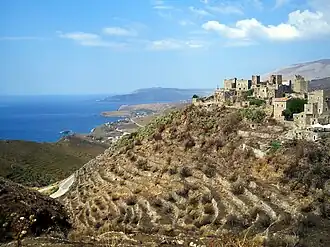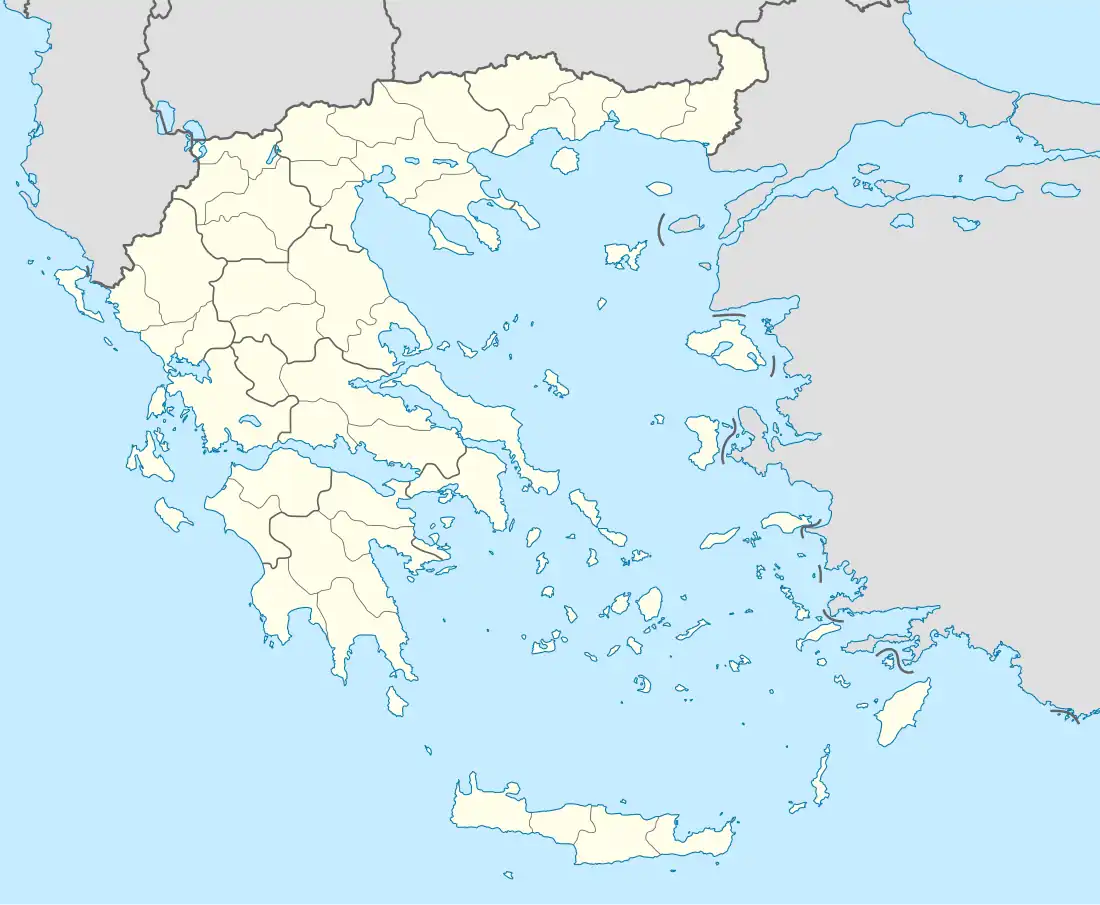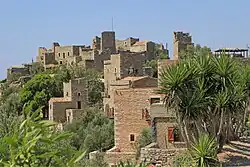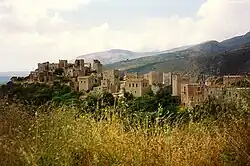Vatheia
Vatheia
Βάθεια | |
|---|---|
 View of Vatheia | |
 Vatheia | |
| Coordinates: 36°27.2′N 22°28.0′E / 36.4533°N 22.4667°E | |
| Country | Greece |
| Administrative region | Peloponnese |
| Regional unit | Laconia |
| Municipality | East Mani |
| Municipal unit | Oitylo |
| Elevation | 180 m (590 ft) |
| Population (2021)[1] | |
• Community | 78 |
| Time zone | UTC+2 (EET) |
| • Summer (DST) | UTC+3 (EEST) |
| Postal code | 230 71 |
| Area code(s) | 27330 |
| Website | www |
Vatheia (Greek: Βάθεια [ˈvaθça]; also Vathia) is a southern Greek village on the Mani Peninsula in southeastern Laconia near the town of Oitylo. It is largely abandoned. Vatheia is known for its hillside tower-houses which overlook the surrounding landscape. Northeast of the village is the Sangias range.
Vatheia is linked by road to Areopoli and Kalamata to its north and Cape Matapan (also known as Tenaro and Tenairon) to the south. Farmland and maquis shrubland cover the hillsides. On the hills and mountainsides around Vatheia proper are clusters of abandoned houses, towers and chapels known as the perichora, meaning "environs".
Vatheia is a popular tourist destination, particularly in spring and summer as wildflowers cover the surrounding hills. It also offers examples of southern Maniot vernacular architecture of the 18th and 19th centuries. The nearest villages are Kyparissos, Alika, and Gerolimenas to the northwest and Lagia to the northeast.
History

Vathia is first mentioned in 1571 by a Venetian diplomatic mission as casale di Vathia.[2]
In 1618 an unofficial census was conducted by an agent of Charles, Duke of Nevers named Philipe de Lange Châteaurenault in cooperation with a prominent Maniot clan leader named Pietro Medici.[3] The village was recorded as "vatia" with 20 hearths.[4]
In 1700 the Grimani census was carried out for the newly established Kingdom of the Morea.[5] The Venetians recorded a total population of 212 persons distributed in 54 families.[6] The reasons for this substantial population growth over the 17th century are unclear.
On 13 April 1805 William Martin Leake passed through Vatheia ("Βάθια" in his text) on the way to Cape Matapan on the coastal road. His journey was briefly interrupted by a band of local armed men. Leake's guides, being Maniots themselves, negotiated passage and informed him that Vatheia has been divided in two warring parties for the past 40 years. They estimated that about 100 men had been killed since the beginning of this clan war. Leake also wrote that Vatheia and its environs consist of three adjacent villages.[7] Between 1750 and 1900 the main habitations—apart from the village itself—were hamlets controlled by eight Vathia clans and their allies. The four largest clans were the Karabatiani, Michalakiani, Kaledoniani, Koutrigari; these families lived in and around Vatheia proper. The other four clans occupied the hamlets.[8]
Below follows a list of the clans with their constituent families:[9]
| Michalakiani | Karabatiani | Kalidoniani | Fidopiastes | Koutrigari | Athanasiani | Stravokefali | Michelongones |
|---|---|---|---|---|---|---|---|
| Angelakos | Alafakis | Kalidonis | Fidopiastis-Kokkinakos | Koutrigaros | Athanasakos | Stravokefalos-Panagiotakos | Michelakis |
| Androutsakos | Andreakos | Karakitsakos | Balinis | ||||
| Gerakarakos-Vasilakos | Georgakakos | Mitsakos | |||||
| Giannakakos | Gligorongonas | ||||||
| Giannoukakos-Pikrologos | Kakleas-Mavroeidakos | ||||||
| Drakoularakos | Kalfakakos | ||||||
| Exarchakos-Arfanakos | Katelanos | ||||||
| Zekakos | Koutrouvis | ||||||
| Kalapothakos | Lagoudis | ||||||
| Keramidas | Laos | ||||||
| Kleftogiannis | Mageris | ||||||
| Mitsakos-Fikardos | Mingiros | ||||||
| Xanthakos | Xypolitos | ||||||
| Patsandonis | Panagakos | ||||||
| Sbaras | |||||||
| Syngikos-Andonakos |

On 15 August 1806, representatives of many prominent Maniot clans gathered in Marathonisi to sign an oath of fealty to Andonis Grigorakis, Bey of Mani. The entry for Vatheia was as follows: "Michalakiani, Gerandoniani and Karabatiani and the environs, we abide collectively".[10] The communal decision to swear fealty to the Bey might have signalled the end of the war mentioned by Leake a year earlier. Furthermore, this is the only known mention of the Gerandoniani clan. The local clan war that started in 1764 was the catalyst in the formation of the clans which dominated the region from the 19th century until its, nearly total, abandonment during the post-World War II years.
Like much of Mani, Vatheia has numerous megalithic remains. These include: Kostakianika Kalyvia,[11] built on a hillside; and Pachia,[12] built in the mountainside opposite the hill of modern Vatheia.
Historical population
| Year | Population |
|---|---|
| 1981 | 60 |
| 1991 | 113 |
| 2001 | 216 |
| 2011 | 33 |
| 2021 | 78 |
See also
References
- ^ "Αποτελέσματα Απογραφής Πληθυσμού - Κατοικιών 2021, Μόνιμος Πληθυσμός κατά οικισμό" [Results of the 2021 Population - Housing Census, Permanent population by settlement] (in Greek). Hellenic Statistical Authority. 29 March 2024.
- ^ C. Comis, Πληθυσμός και Οικισμοί της Μάνης 15ος-19ος αιώνας, 2nd edition, Ioannina, 2007, p. 396
- ^ op.cit., p.40
- ^ op.cit., p. 585
- ^ op.cit., p. 48
- ^ op.cit., p. 599
- ^ William Martin Leake, Travels in the Morea: With a map and plans, Vol.I, John Murray publishing house, London, 1830, p. 294-295
- ^ Yanis Saitas, MANI, publishing house MELISSA, Athens, 2001, p.115
- ^ Yanis Saitas, Cemeteries and Settlements of Mani in Medieval and later periods: a 2nd contribution, Honouring the Dead in the Peloponnese, proceedings of the conference held at Sparta 23–25 April 2009, edited by Helen Cavanagh, William Cavanagh and James Roy, University of Nottingham, Centre for Peloponnesian Studies, CSPS Online Publication 2 prepared by Sam Farnham, p. 709
- ^ Anonymous, Ιστορικαί Αλήθειαι Συμβάντων Τινών της Μάνης, τύποις Φ. Καραμπίνη & Κ. Βάφα, 1858, p. 45
- ^ https://dokumen.pub/medieval-and-post-medieval-greece-the-corfu-papers-9781407305981-9781407335506.html Medieval and Post-Medieval Greece: The Corfu Papers 9781407305981, 9781407335506 - DOKUMEN.PUB
- ^ https://www.ascsa.edu.gr/uploads/media/hesperia/147050.pdf https://www.ascsa.edu.gr/uploads/media/hesperia/147050.pdf